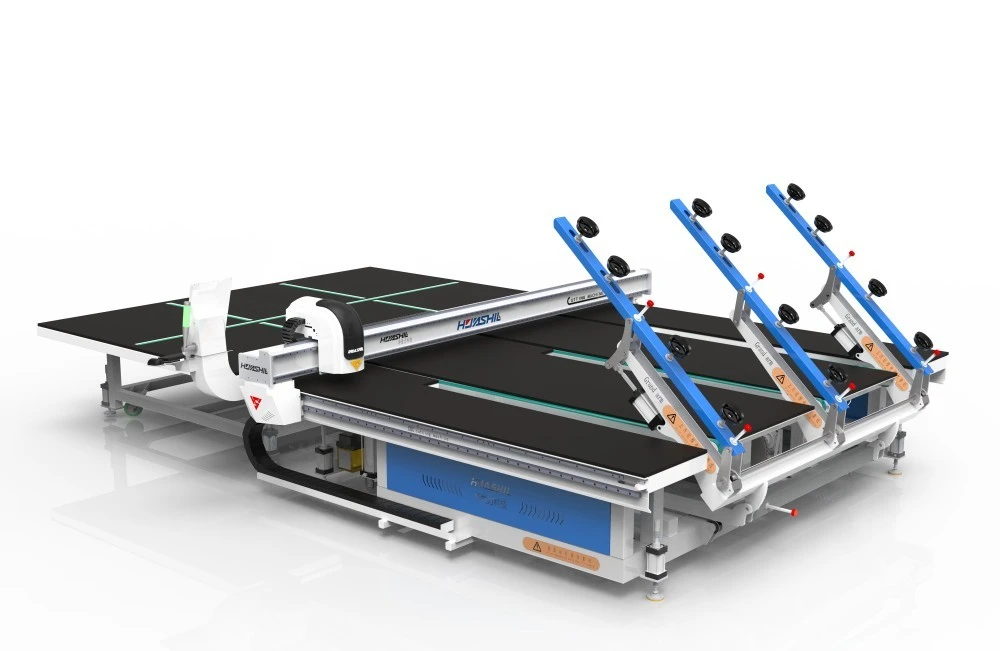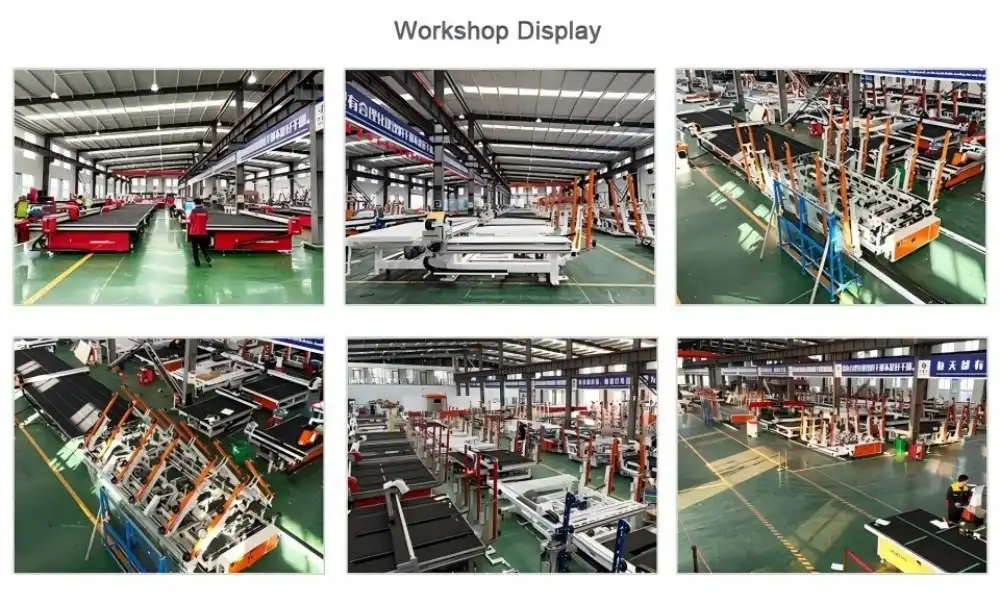Glass deep cutting machines are essential tools in various industries, from architectural glass production to automotive manufacturing. However, one common challenge that operators face is glass chipping during the cutting process. Chipping not only affects the quality of the final product but can also lead to increased waste and production costs. In this comprehensive guide, we'll explore effective strategies to minimize chipping and achieve cleaner, more precise cuts with your glass deep cutting machine.
Common causes of glass chipping during cutting
Before we delve into solutions, it's crucial to understand the root causes of glass chipping. By identifying these factors, you can take targeted actions to address them:
- Improper cutting wheel pressure: Excessive pressure can cause micro-fractures that lead to chipping.
- Incorrect cutting speed: Cutting too fast or too slow can result in uneven stress distribution and chipping.
- Dull or damaged cutting wheels: Worn-out tools can create rough edges and increase the likelihood of chipping.
- Inadequate cooling: Insufficient lubrication during cutting can cause localized heating and thermal stress.
- Poor glass quality: Impurities or internal stresses in the glass can make it more susceptible to chipping.
- Improper handling: Mishandling of glass sheets before or after cutting can induce stress points.
Understanding these common culprits will help you implement targeted solutions to reduce chipping in your glass deep cutting machine.

Adjusting machine parameters to minimize chipping
Fine-tuning your glass deep cutting machine's parameters is crucial for achieving chip-free cuts. Here are some key adjustments to consider:
Optimize cutting wheel pressure
The pressure applied by the cutting wheel is a delicate balance. Too much pressure can cause micro-fractures, while too little may result in incomplete cuts. Experiment with different pressure settings to find the optimal range for your specific glass type and thickness. Many modern glass cutting equipment allow for precise pressure control, so take advantage of this feature.
Adjust cutting speed
The ideal cutting speed for a glass deep cutting machine varies depending on glass thickness and composition. Generally, slower speeds are better for thicker glass, while faster speeds work well for thinner sheets. Start with the manufacturer's recommended settings and make incremental adjustments until you achieve clean cuts consistently.
Fine-tune scoring depth
The depth of the initial score line is crucial for clean breaks. A score that's too shallow may not propagate properly, while an overly deep score can cause chipping. Aim for a scoring depth of about 10-15% of the glass thickness for optimal results.
Optimize coolant flow
Proper lubrication is essential for reducing friction and heat during glass deep cutting machine operations. Ensure your coolant system is functioning correctly and delivering an adequate amount of lubricant to the cutting area. Some operators find success with specialized cutting fluids designed for glass processing.
Adjust break-out pressure
If your cutting machine for glass has an automated break-out feature, fine-tune the pressure settings. Too much force during break-out can cause chipping at the edges. Gradually increase the pressure until you achieve clean separations without excess chipping.

Innovative tools and techniques for chip-free cuts
Beyond machine adjustments, there are several innovative approaches you can employ to further reduce chipping:
Advanced cutting wheel materials
Consider upgrading to cutting wheels made from advanced materials like polycrystalline diamond (PCD) or cubic boron nitride (CBN). These materials offer superior hardness and wear resistance, resulting in cleaner cuts and reduced chipping over time.
Laser-assisted scoring
Some cutting-edge glass deep cutting machines incorporate laser technology to create a precise initial score line. This technique can significantly reduce the mechanical stress on the glass, leading to cleaner breaks and less chipping.
Ultrasonic-assisted cutting
Ultrasonic vibration applied to the cutting wheel can help reduce friction and improve cut quality. This technology is particularly effective for cutting thick or laminated glass.
Controlled fracture techniques
Instead of relying solely on mechanical scoring and breaking, some advanced systems use controlled thermal stress to initiate and guide the fracture. This method can result in exceptionally clean edges with minimal chipping.
Edge polishing integration
Consider investing in a glass deep cutting machine that integrates edge polishing capabilities. This allows for immediate smoothing of cut edges, reducing the risk of chipping during subsequent handling and processing.
Optimized glass handling systems
Implement automated handling systems that minimize manual contact with the glass. This reduces the risk of stress-induced chipping and ensures consistent positioning throughout the cutting process.
Advanced break-out methods
Explore sophisticated break-out techniques, such as using focused heat or specialized bending mechanisms, to achieve clean separations without applying excessive force.
Smart sensor integration
Incorporate sensors that can detect glass thickness variations or internal stresses. This data can be used to automatically adjust cutting parameters for optimal results.
Machine learning algorithms
Some state-of-the-art glass cutting systems now employ machine learning algorithms to continuously optimize cutting parameters based on real-time feedback and historical data.
Regular maintenance and calibration
While not a cutting-edge technique, consistent maintenance of your glass deep cutting machine is crucial. Regular calibration, wheel replacement, and system checks can prevent many chipping issues before they occur.
Pre-cutting glass preparation
Consider implementing a glass preparation step, such as edge seaming or stress relieving, to minimize the risk of chipping during the main cutting process.
Post-cutting treatments
Explore post-cutting treatments like chemical etching or flame polishing after glass deep cutting machine operations to smooth out any minor imperfections and reduce the likelihood of chip propagation.
Environmental control
Maintain a stable temperature and humidity in your cutting area. Fluctuations in environmental conditions can affect glass behavior during cutting.
Specialized coatings
Some manufacturers offer protective coatings that can be applied to the glass surface before cutting. These coatings can help reduce friction and prevent micro-fractures that lead to chipping.
Optimized cutting patterns
Use advanced software to design cutting patterns that minimize stress on the glass. This can include optimizing the sequence of cuts and incorporating stress-relief cuts where necessary.
By implementing a combination of these innovative tools and techniques, you can significantly reduce chipping in your glass deep cutting machine operations, leading to higher quality products and improved efficiency.
Continuous improvement process
Establish a systematic approach to tracking and analyzing cutting performance. Regularly review data on chip rates, cut quality, and production efficiency to identify areas for improvement and refine your cutting processes continually.
Staff training and skill development
Invest in comprehensive training programs for your operators. Well-trained staff can better understand the nuances of glass cutting and make informed decisions to prevent chipping.
Collaboration with glass suppliers
Work closely with your glass suppliers to ensure you're receiving materials optimized for your cutting processes. They may be able to provide glass with specific properties that are less prone to chipping.
Custom tooling solutions
Consider partnering with tooling manufacturers to develop custom cutting wheels or scoring tools tailored to your specific glass types and production requirements.
Vibration dampening systems
Implement advanced vibration dampening technologies in your glass deep cutting machine setup to minimize unwanted movements that can lead to chipping, especially when working with large or delicate glass sheets.

Quality control integration
Integrate automated quality control systems that can detect and flag potential chipping issues in real-time, allowing for immediate adjustments to the cutting process.
By combining these strategies with the machine adjustments and innovative techniques discussed earlier, you can create a comprehensive approach to minimizing chipping in your glass deep cutting operations.
Remember, reducing chipping is an ongoing process that requires attention to detail, continuous monitoring, and a willingness to adapt to new technologies and methods. With persistence and the right approach, you can significantly improve the quality and efficiency of your glass cutting processes.
Conclusion
Reducing chipping in glass deep cutting machines is a multifaceted challenge that requires a combination of technical know-how, innovative approaches, and continuous improvement. By understanding the root causes of chipping, optimizing machine parameters, and embracing cutting-edge technologies, you can significantly enhance the quality of your glass cutting operations.
At Shandong Huashil Automation Technology Co., LTD, we understand the critical importance of precision and quality in glass processing. Our advanced glass deep cutting machines are designed to meet the exacting standards of modern glass manufacturing, incorporating many of the innovative features and technologies discussed in this article. With years of experience in automated R&D, manufacturing, and sales of mechanical equipment, we are committed to providing solutions that drive efficiency and quality in your glass cutting operations.
Ready to take your glass cutting capabilities to the next level? Contact our expert team at salescathy@sdhuashil.com to learn more about our state-of-the-art glass deep cutting machines and how they can revolutionize your production process. Let us help you achieve chip-free, high-precision cuts that meet the demands of today's competitive market.
References
1. Johnson, M. (2022). Advanced Techniques in Glass Deep Cutting: Minimizing Chipping and Maximizing Efficiency. Journal of Glass Technology, 45(3), 78-92.
2. Zhang, L., & Chen, H. (2021). Innovative approaches to reduce chipping in automated glass cutting processes. International Journal of Manufacturing Technology, 16(2), 205-218.
3.Patel, S. (2023). The impact of machine learning on glass cutting precision: A comprehensive review. Smart Manufacturing Systems, 8(4), 412-429.
4. Brown, A., & Smith, R. (2022). Optimization of cutting parameters for chip-free glass processing: An experimental study. Advances in Materials Science and Engineering, 2022, 1-15.



